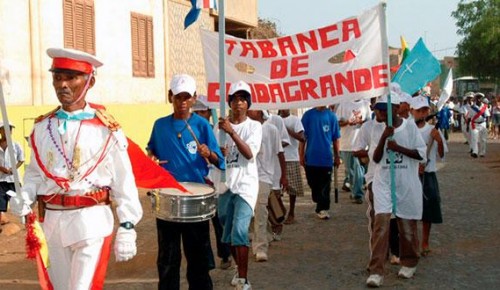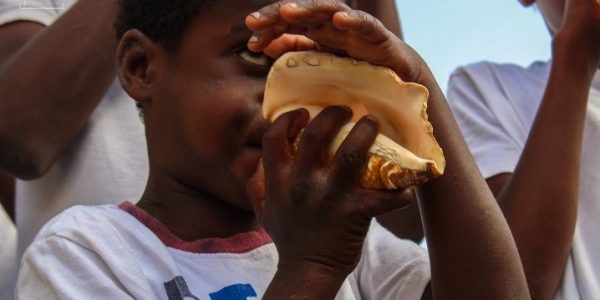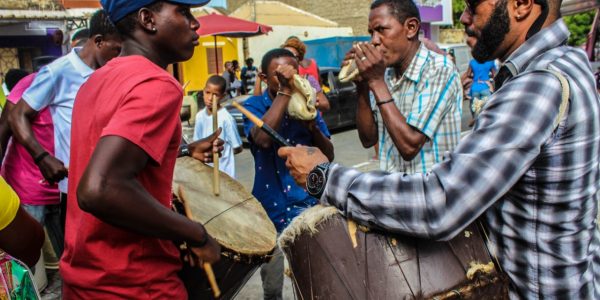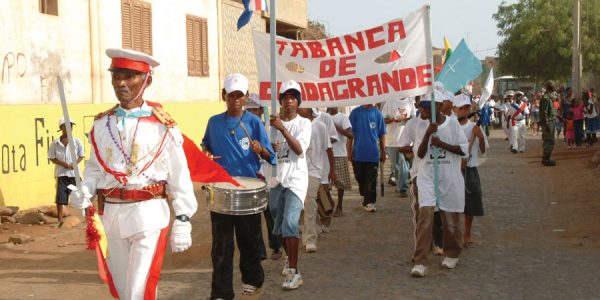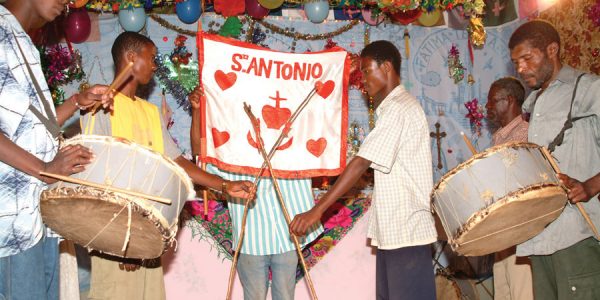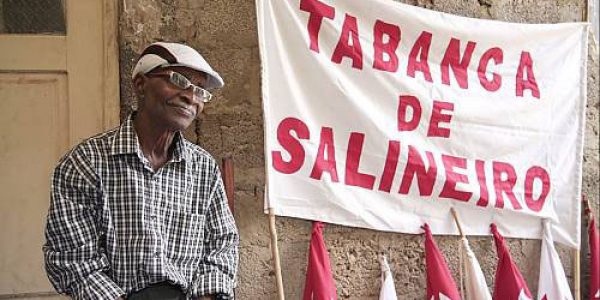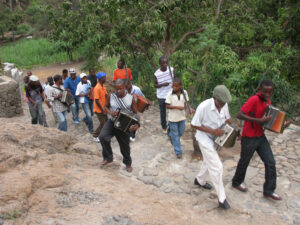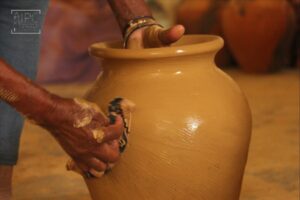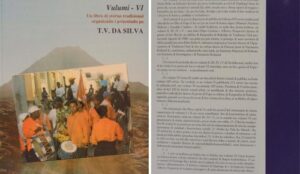The tabanca festivities begin with a set of preparations that culminate with activities on the day of the group's patron saint.
In Praia, the preparations usually start a few weeks before the patron saint's day, with fund-raising from public and private entities and from the community itself.
Esses apoios financeiros servem para a compra de elementos decorativos para a ornamentação da corte, manutenção e renovação de instrumentos musicais e outros equipamentos que fazem parte do desfile de buska santu, aquisição de alimentos e outros utensílios necessários para a comensalidade do grupo, durante toda a festividade, a confeção da indumentária do grupo e o pagamento da dívida à rainha ou ao rei di gazadju.
ler maisUsually for a week before the day of the patron saint, activities begin with the o “toque de salva” in the group's chapel, which consists of a sacred ceremony presided over by the” rei di korti” at dusk, which is equivalent to the prayer of the Catholic rosary, through ringtones. drum, kiss and dança das varas de salva rituals ( sage stick dance); presentation and dancing of the flag by the “rei de corte”; chant of the litany and ended with the sound of the tabanca. At the same time, a group of women is preparing a soup for everyone present. Afterwards, batuku is celebrated in th“terreiro”, in a circle space in front of the tabanca chapel and in the middle, women usually dance into the night to the sound of the txabeta, which sets the beat of the batuku. On the eve of the patron saint's day, batuku is celebrated until dawn.
In the interior of the Santiago island, the groups start their festivities a few days before the day of their respective patron saint with a meeting among their members, which is usually presided over by the rei do grupo (king of the group), with the purpose of taking all the important decisions for the good development of their festivities. These decisions are mainly related to the use of funds raised by the group, namely through membership fees, public and private institutions, remittances from former members or family members who are in the diaspora, among others.
On the eve of the day of the patron saint of the group, some members go in the morning to the chapel of the tabanca to carry out the ornamentation of the corte, which is locally called “arma korti”. Other members will simultaneously decorate the streets of the town, where the procession and the tabanca parade will pass. In the evening, the men proceed to the slaughter of animals (pig and goat), for the festivity. The women gather to prepare the food and collect the kitchen utensils from the neighborhood, as the group will be insufficient for everyone who attends the party. They make soup for those present while the drumming continues until dawn. During the early hours of the morning, they put the beans on the fire, which will be used in the menu of the great popular meal on the day of the patron saint.
In the city of Porto Inglês, on the island of Maio, around the tenth day of April, a group of people, mostly members of Tabanca Djarmai, coming mainly from an area called Pariba, wander around, to the sound of the drum and women singing), around the city from house to house asking for help for the festivities of the tabanca, whose culmination is celebrated on May 3, the day of its patron saint: Santa Cruz.
Each one offers what they can, according to their financial condition and all aids are considered equally. The members of the tabanca also count on aid from other locations on the island, remittances from emigrants who return to their homeland every year to proudly attend the festivities of Santa Cruz and, from some public institutions, namely the Ministry of Culture and the local City Council.
About a week before the day of Santa Cruz, a rainha e o rei (the queen and king) of the Djarmai Tabanca meet, who are also the judges of the feast of Santa Cruz. Before this, a rainha (the Queen) orders a firework to be fired outside her house, and theno rei ( the King ) orders the same to be fired in reply. The rainha and her procession leave, to the sound of the drum, the horns (conch shells) and the singers women, to meet the rei , who is also accompanied in the same way, but covered with a quilt held on all fours by his escorts. After the meeting, the two groups merge and form a single procession which goes towards to the Queen's house (a casa da rainha)
A Casa da rainha (The queen's house) is transformed into the place where the whole tabanca festival takes place. With the arrival of several people from different locations on the island, each bringing some offer, especially food and drinks, what they call kotxida, which consists of grinding the milho no pilão, (corn in the pestle), animated by the sound of the drum and songs of the singers women and simultaneously with the killing of animals. Pans are brought to the fire, food made from corn, xerém and cachupa is distributed, and batuku is made in the middle of the terreiro, late into the night. This ritual is repeated until the eve of the day of Santa Cruz.
The 2nd of May is the day for the decoration of the corte, in which women essentially participate. It is a long task that requires a lot of knowledge of the technique and consists of fixing a white sheet to the wall, on which cross-shaped scarves, cakes, candies, etc. In front of the sheet is placed a table on which the altar is decorated, where candles and sacred symbols will be placed: the wooden cross and the dolls, with the male and female representing the o juiz (judge) . A blue quilt opens on the ceiling, which represents the sky and is so called, where the same products as on the sheet are also affixed. This is the sacred space of the festivity. On this day the festivities traditionally go on until dawn.
Saint Patron's Day: in the city of Praia, early in the morning, thieves and other captives head to the church to attend the mass requested by the tabanca, celebrated in honor of the patron saint. After the mass, the thieves return to the town and have breakfast in the small backyard of the tabanca chapel. Then they go to corte to steal the saint from the altar, which is usually manned by a group of soldiers. The saint, who is robbed, is represented by a little white flag with a small red cross in the middle and a sage stick. na cidade da Praia, de manhã cedo, os ladrões e outros cativos dirigirem-se à igreja para assistirem à missa solicitada pela tabanca, celebrada em honra do santo patrono. Após a missa, os ladrões regressam à localidade e tomam o pequeno-almoço no pequeno quintal da capela da tabanca. De seguida, vão para a corte para roubar o santo no altar, que se encontra geralmente guarnecido por um grupo de soldados. O santo, que é roubado, é representado por uma bandeirinha branca com uma pequena cruz vermelha no meio e uma vara de salva.
After succeeding in stealing the saint, the thieves quickly run out of the chapel publicly displaying their victory and heading to the house of the rainha e rei (queen or king ) to sell the saint and the flag of the patron saint is placed at half mast, which is usually hoisted in front of the chapel. The group thus demonstrates that it is in mourning, because of the saint who has already been stolen.
When they arrive at the house of the queen or king of tabanca, who is the person who commits with the group to buy the saint for seven years, the thieves negotiate the sale of the saint with the queen or king of tabanca. After the deal has been made, the queen or garment king orders the saint to be kept in a safe place and then orders a banquet to be offered to the thieves and a get-together is established there. At the end, the thieves agree with the queen or king of clothing the day on which the group of the tabanca will pick up the saint, according to the availability of the queen or King of tabanca.
The thieves then return to the place to try to win the flag or the saint, which consists of touching the flag at half-mast in the street before being captured by the flag garrison or grabbing the king or queen of the court before being captured by the soldiers of the tabanca. If they manage to win the flag they will be cleared, otherwise they will be subjected to interrogation and flogged. After that, food and drink is distributed to everyone present and the party is celebrated all night.
On the day of the busca do santo (pick up of saint), everyone goes to the chapel of the tabanca. The preparations for the parade begin with the beat of the way, which is performed by a boy carrying a vara de salva (sage stick), followed by two drummers. At the end, the “rei of corte” takes the vara de salva and presides over a short salute ceremony, and at the end he orders the start of the parade.
The procession leaves the place with the commander at the head and his troops, the rainha e o rei de campo accompanied by the saint daughters and the rei e rainha de corte, who organises the rules of the tabanca. The carrasco (the executioner), who organises and protects the group from the rest of the outsiders. The drummers and the buglers who entertain the crowd with the frenetic rhythms of the drum and the conch. As the group passes through the various locations, the parade gets gradually thicker with more people.
While the parade is in progress, the falcon tries to steal the saint from the na casa da rainha ou o rei de agasalho (the house of the queen or the king) . If he does not succeed in his attempt, after a while the rei and the rainha (queen or king ) takes pity on him and gives him back only the little flag and keeps the stick in his possession as a form of guaranteeing the return of the amount with which he had bought the saint from the tabanca group. Sometimes the a rainha ou o rei de agasalho, of their own free will, can forgive half or all of the debt, in favour of their gift to the saint, which remains for the group's fund.
The “falcon” runs in the direction of the group which is approaching in procession, which, in turn, arriving near the house of the a rainha ou o rei de agasalho, the group slows its pace and the drums and bugles start to play the “salva” and when the falcon arrives at its meeting and hands over the flag to the rei do campo or in his absence, to the rei of corte, the drums and bugles start to play again frantically and the procession takes its course towards the house of the da rainha ou rei de agasalho. In the house of rainha ou rei de agasalho the rei de corte commands the toque de salva the group enters the house, at end leaves the materials they have brought with them at the base of a small altar improvised by the rainha ou o rei de agasalho: the drums, the bugles, the boats, the planes, the rifles, among other things, transforming the space into a temporary corte. Afterwards, everyone will enjoy food and drink and a great conviviality until the early hours of the morning.
The following day, the group organises itself to return in parade to their locality. On their return, they place the saint on the altar. To finish the festivities of that year, a ceremony is organised on another day, which is locally called lába tripa, in which consists of a feast to consume all the easily perishable food products left over.
In the interior of the island of Santiago, on the day of the patron saint, at the request of the tabanca, the parish priest celebrates mass in the community of the chapel of the tabanca, followed by a procession through the streets of the area. Usually in the evening, the praying priests lead the litany in the chapel of tabanca. Afterwards those present gather for the party of tabanca and the batuque until Dawn.
No dia seguinte, os membros do grupo concentram-se na capela para organizar uma saída para fora da localidade, onde fazem visitas a familiares e amigos de Santo patrono e depois realizam uma visita de cortesia à rainha ou rei de oferta, onde servir-lhes-ão comida, bebida e uma oferta monetária para o fundo do grupo. Todos os anos cada grupo tem a obrigação de efetuar este ritual aos antigos reis e rainhas de oferta, que localmente denominam de báxa koroa. Ao regressar à localidade distribui-se comida e bebida para todos os presentes e depois festeja-se a tabanca e o batuque até madrugada.
No dia subsequente, o grupo se dirige para a casa do atual rei ou a rainha de oferta, onde serão recebidos com comida, bebida e oferenda monetária para o fundo do grupo. Durante o trajeto o grupo vai visitando os vários emigrantes que regressam à terra natal, para visitar a família e assistir as festividades. Posteriormente, o grupo regressa, sob o comando do rei ou rainha de oferta, que vai acompanhado no desfile pelos seus convidados, para a localidade da tabanca. Ali, serão também recebidos com comida, bebida, festa da tabanca e batuque, na capela tabanca, que durará até de madrugada. Depois disso, o grupo fará uma pausa por alguns dias.
After that, the group organizes the ceremony for the public auction of the foodstuffs with which the corte was decorated, namely bananas, sugar cane, mango, manioc, and other foods, but as long as it is not on a Friday, because normally there is a bad auspice with the auction taking place on that day. After this, the festivity of the tabanca ends.
In the city of Porto Inglês, on May 3, the day of Santa Cruz, in the morning a mass is celebrated in honour of Santa Cruz in the mother church.
In the afternoon, the procession leaves the juíza`s house towards the cross, which is located in Salina. At the head of the procession is the wooden cross, which is usually carried by a boy. Then come the two servants, a little boy and girl who take the doll, in front of the party juíza (judges). Behind them follow the prayers, who make the whole route singing the litany. Some faithful accompany this group praying the rosary along the way. Soon after, comes the group from the village of Djarmai, which distances itself a few meters from the previous group, to the sound of the drum and trumpets, thus safeguarding a division between the sacred and the profane. And finally, come young of juízes of tabanca, accompanied by their group also to the sound of drums and cornets. In Salina, the faithful gather in front of the cross, all decorated with flowers and where the wooden cross and the dolls will be placed at its base. Then proceeds to the sacred ceremony, normally led by the local parish priest and at the end the juízes of the groups of Tabanca de Djarmai and Tabanca Jovem (joung) will be announced for the next year by the president of the Djarmai tabanca group.
On the way back, the Tabanca groups parade circling the cross three times and then follow their way back, in the procession with the same order as before. The procession, before reaching its destination, the house of juíza, makes a short pause at the houses of the former juízes of Santa Cruz and, finally, the house of the new Juiza before the house of the juízes of party. Once they arrive at the juízes` house, where a copious feast awaits them, the juízes first make an inventory of the tables, pots, drinks, among other products and hand them over on a piece of paper to the juízes of the next year. Then, the tables are opened and everyone present enjoys the feast that goes on well into the night.
In the next few days, the faithful will go to the juíza`s house in the afternoons to pray the rosary in corte and at the end, cachupa and chicken soup and rice will be distributed.
A few days later, there is, traditionally on a Friday or Saturday, the last ceremony that indicates the end of the festivities of the Tabanca de Santa Cruz, on the island of Maio: xinta cruz. On eve, the drum is played until dawn. Around five o'clock in the morning, the withdrawal from the corte takes place. First, remove all objects placed on the sheet and, lastly, the sheet. Then all the objects placed in the “heaven” are removed and then the bedspread. All the dismantling of the corte is done to the sound of the ceremonial beating of the drum.
The wooden cross is taken to the house of the person who had previously made himself available to keep it until the next year.
The dolls will be delivered to the juíza of the following year, the successor of the rainha de Tabanca de Djarmai (queen of Tabanca de Djarmai), who immediately sends them to each house in the twelve locations, circling the island: Barreiro, Figueiras, Ribeira Dom João, Pilão Cão, Alcatraz, Pedro Vaz, Santo António and Praia Gonçalo, Cascabulho, Morrinho, Calheta, Morro and returns to Porto Inglês. For each house they pass, people kiss them and pray the rosary and order to offer what they can to the juíza. Usually the dolls are sent in the month of May and return in the month of March or April of the following year. The A juíza will have to dress the dolls again in white satin at the time of the Santa Cruz party, because they return practically dirty of so much handling.
After an exhaustive inventory process with the communities, the State of Cabo Verde classified the Tabanca Manifestation as National Intangible Cultural Heritage, on August 9, 2019, the date on which the Cabo Verdean language was also elevated to National Heritage.
ler menos


